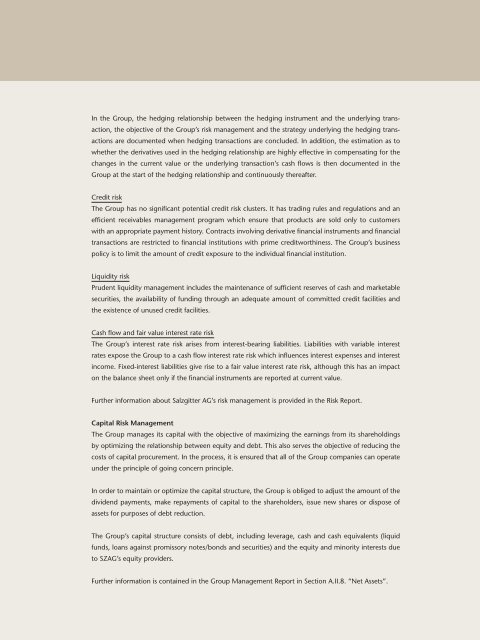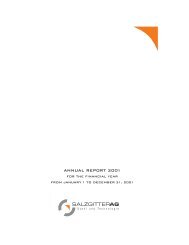Download - Salzgitter AG
Download - Salzgitter AG
Download - Salzgitter AG
Create successful ePaper yourself
Turn your PDF publications into a flip-book with our unique Google optimized e-Paper software.
In the Group, the hedging relationship between the hedging instrument and the underlying transaction,<br />
the objective of the Group’s risk management and the strategy underlying the hedging transactions<br />
are documented when hedging transactions are concluded. In addition, the estimation as to<br />
whether the derivatives used in the hedging relationship are highly effective in compensating for the<br />
changes in the current value or the underlying transaction’s cash flows is then documented in the<br />
Group at the start of the hedging relationship and continuously thereafter.<br />
Credit risk<br />
The Group has no significant potential credit risk clusters. It has trading rules and regulations and an<br />
efficient receivables management program which ensure that products are sold only to customers<br />
with an appropriate payment history. Contracts involving derivative financial instruments and financial<br />
transactions are restricted to financial institutions with prime creditworthiness. The Group’s business<br />
policy is to limit the amount of credit exposure to the individual financial institution.<br />
Liquidity risk<br />
Prudent liquidity management includes the maintenance of sufficient reserves of cash and marketable<br />
securities, the availability of funding through an adequate amount of committed credit facilities and<br />
the existence of unused credit facilities.<br />
Cash flow and fair value interest rate risk<br />
The Group’s interest rate risk arises from interest-bearing liabilities. Liabilities with variable interest<br />
rates expose the Group to a cash flow interest rate risk which influences interest expenses and interest<br />
income. Fixed-interest liabilities give rise to a fair value interest rate risk, although this has an impact<br />
on the balance sheet only if the financial instruments are reported at current value.<br />
Further information about <strong>Salzgitter</strong> <strong>AG</strong>’s risk management is provided in the Risk Report.<br />
Capital Risk Management<br />
The Group manages its capital with the objective of maximizing the earnings from its shareholdings<br />
by optimizing the relationship between equity and debt. This also serves the objective of reducing the<br />
costs of capital procurement. In the process, it is ensured that all of the Group companies can operate<br />
under the principle of going concern principle.<br />
In order to maintain or optimize the capital structure, the Group is obliged to adjust the amount of the<br />
dividend payments, make repayments of capital to the shareholders, issue new shares or dispose of<br />
assets for purposes of debt reduction.<br />
The Group’s capital structure consists of debt, including leverage, cash and cash equivalents (liquid<br />
funds, loans against promissory notes/bonds and securities) and the equity and minority interests due<br />
to SZ<strong>AG</strong>’s equity providers.<br />
Further information is contained in the Group Management Report in Section A.II.8. “Net Assets”.











